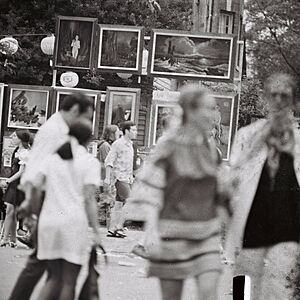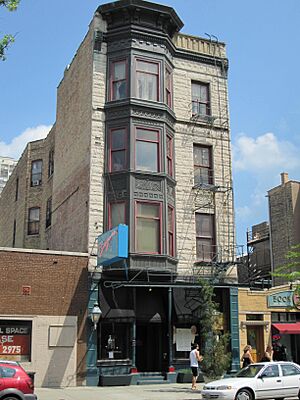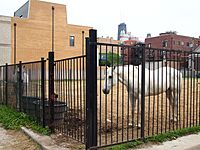Old Town, Chicago facts for kids
|
Old Town Triangle Historic District
|
|
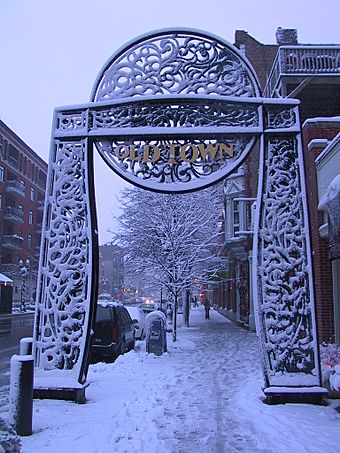
An Old Town sign at Wells Street and North Avenue
|
|
| Lua error in Module:Location_map at line 420: attempt to index field 'wikibase' (a nil value). | |
| Location | Chicago, Illinois, U.S. |
|---|---|
| Built | 1872 |
| Architectural style | Italianate, Queen Anne |
| NRHP reference No. | 84000347 |
Quick facts for kids Significant dates |
|
| Added to NRHP | November 8, 1984 |
Old Town is a cool neighborhood and a historic area in Chicago, Illinois. It's known for its many old buildings from the Victorian era. One famous building is St. Michael's Church, which was one of only seven buildings to survive the Great Chicago Fire.
Contents
Exploring Old Town's Location and Name
In the 1800s, many German and Luxembourgish immigrants settled here. They turned the swampy land into farms, growing vegetables like celery and cabbage. This led people to call the area "The Cabbage Patch" until the early 1900s.
During World War II, a special triangle area (made by North Avenue, Clark Street, and Ogden Avenue) was named a 'neighborhood defense unit'. After the war, the people living in "North Town" (as it was called then) started annual art fairs. These fairs were very popular. The name "Old Town" was used when the Old Town Triangle Association was formed in 1948. Residents created this group to help fix up buildings that were getting old and worn out.
In the 1950s, many of the first Puerto Ricans to come to Chicago lived in Old Town. They sometimes called this area "La Clark."
Old Town isn't an official legal area. Its borders are not set in stone. People have different ideas about where Old Town truly is:
It is important to stress that there is no such legal entity as Old Town. Old Town is where you make it.
This neighborhood is supposed to be as much a sound as a place, and it's from the bells of St. Michael's Church. The story goes you only really live in Old Town if you can hear them.
... it was said that all who lived within hearing distance of the church's bells were Old Towners.
Old Town's History: From Past to Present
The 1800s: Early Beginnings
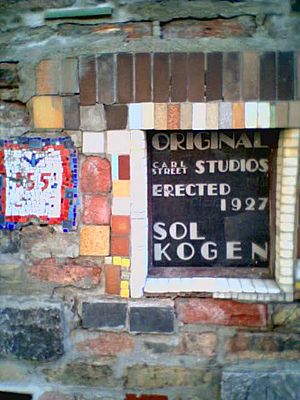
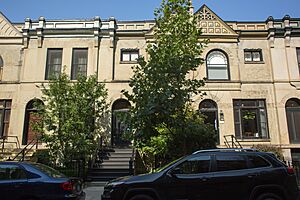
Before European settlers arrived, the land that is now Old Town was home to many Native American nations. These included the Potawatomi, Miami, and Illinois peoples. They used the area as a home and a place for trading.
After the 1833 Treaty of Chicago, most Native Americans were forced to leave. In the 1850s, German-Catholic immigrants began to settle the land. Clark Street is an old road from that time. It followed a small ridge near Lake Michigan.
Old Town has many of Chicago's oldest buildings from the Victorian era. St. Michael's Church was originally built by Bavarians. It was one of only seven buildings that survived the Great Chicago Fire within the area.
Many streets and alleys in the Old Town Triangle section are even older than the Great Chicago Fire. They don't always follow Chicago's usual straight grid pattern.
The 1900s: Growth and Change
Old Town has a train station called Sedgwick. It's one of the oldest 'El' stations still standing, built in 1900.
In 1924, the first organization in American history to support gay rights was started here. It was called the Society for Human Rights. Henry Gerber founded it at his home, the Henry Gerber House, which is now a Chicago Landmark and a National Historic Landmark.
In 1927, two sculptors, Sol Kogen and Edgar Miller, bought and fixed up a house on Burton Place. They turned it into the Carl Street Studios. In the 1930s, many artists moved to the neighborhood, creating an art colony.
During the 1960s, Old Town became a center for new ideas and different ways of living. Many of the original families had moved away, leaving older buildings with affordable storefronts. This made it a great place for new shops and creative people. A community of Puerto Ricans also formed here. This area became a hub for unique shops, like the first Crate & Barrel store.
There is a little piece of Chicago Real Estate, west of Lincoln Park, that is the pride of urban conservationists and the despair of bulldozers. It is a community widely known as Old Town ... Old Town is full of conflict, full of life; a sometimes maddening but always exciting place to live.
Important events during the 1968 Democratic National Convention happened in nearby Grant Park and Lincoln Park, close to Old Town.
I pointed out that it was in the best interests of the City to have us in Lincoln Park ten miles away from the Convention hall. I said we had no intention of marching on the Convention hall, that I didn't particularly think that politics in America could be changed by marches and rallies, that what we were presenting was an alternative life style, and we hoped that people of Chicago would come up, and mingle in Lincoln Park and see what we were about.
From the 1960s through the 1980s, Old Town was a place where many gay and lesbian people lived. It was the first such community in Chicago. As the area became more expensive, many residents moved to other neighborhoods further north.
In the 1960s and 1970s, Old Town was also a big center for folk music. The Old Town School of Folk Music opened here in 1957. Famous singer-songwriters like Steve Goodman and John Prine played at clubs on Wells Street. One popular club was Mother Blues, which hosted many well-known artists and comedians.
Some places from the 1960s are still around today. These include Crate & Barrel, The Second City comedy club, the Old Town Ale House, and the Fudge Pot candy shop. The Old Town School of Folk Music moved, but kept its name.
After the assassination of Martin Luther King Jr. and the riots that followed, the neighborhood saw some changes. In recent years, the area south of North Avenue has been developing with new homes. This has brought new people to the neighborhood. The removal of the Cabrini–Green housing projects nearby has also changed the area.
The 2000s: Modern Old Town
Today, Old Town has cultural spots like the Old Town Triangle Art Center. It also hosts the yearly Old Town Art Fair. The Noble Horse Theater, a historic building, was sadly damaged by fire in 2015. The land was later used for new homes.
Learning in Old Town: Schools
Chicago Public Schools (CPS) runs the public schools in the Old Town area.
Manierre K–8 School is one of the schools here. In the 2010s, CPS thought about combining Manierre with another school, Jenner K–8. However, there were concerns about students having to cross different neighborhood areas. So, both schools stayed open.
Famous People from Old Town




